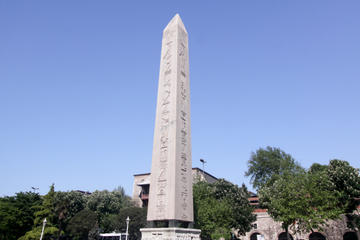Egyptian Obelisk
TIME : 2016/2/22 16:37:42

Egyptian Obelisk
The Egyptian Obelisk is also known as the Obelisk of Theodosius or the Obelisk of Thutmose III. The Egyptian pharaoh Thutmose III originally ordered the construction of the obelisk in the 15th century B.C. at the temple of Karnak, near present-day Luxor. The Roman Emperor Constantius II transported the obelisk up the Nile River to Alexandria in the year 357 to commemorate his twentieth year in power. It remained there until Byzantine Emperor Theodosius moved it to Istanbul in 390 and erected it what was then known as the Hippodrome of Constantinople.
Built at the same time as the Lateran Obelisk that stands in the Circus Maximus in Rome, the Egyptian Obelisk was made of red granite from Aswan and once stood 30 meters tall. Due to damage to the base during transport, today it stands just under 20 meters high, not including its pedestal. The four sides of the obelisk feature inscriptions celebrating a military victory by Thutmose III in 1450 B.C. and carvings on the marble pedestal date back to 390, when it was re-erected in the Hippodrome.
Practical Information
The Obelisk still stands on the site of the Hippodrome, now known as Sultan Ahmet Square (also At Meydani or Sultan Ahmet Meydani), not far from the Blue Mosque. Get there by taking the tram to the Sultanahmet stop.
